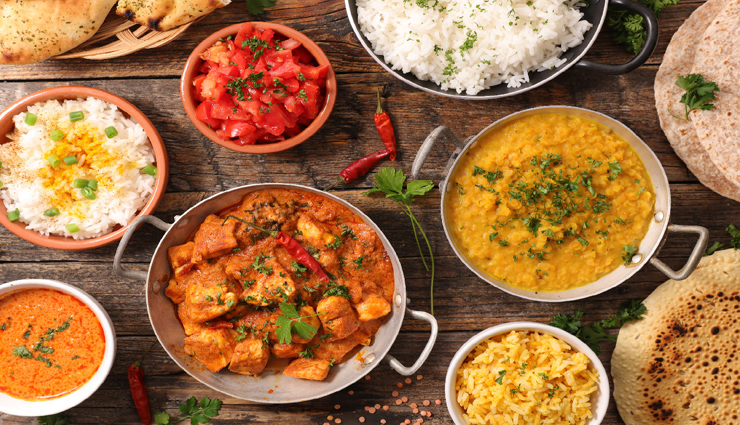7 Misconceptions About Indian Food You Should Not Believe
By: Priyanka Maheshwari Sun, 20 Sept 2020 5:07:17

What is the first thing that pops up in the mind when thinking about Indian Food? Oily, rich, fatty, time-consuming cooking and what not! Even though Indian food is popular across the globe yet it has been highly misunderstood. International Tourists coming to India have some common food-safety misconceptions related to food that are just not true and stop them from consuming it. But that doesn’t really mean that they are unsafe. So allow me to uncover and burst some myths in India that would help you consume them without giving a second thought and make the most out of your India Tour without falling sick. Let’s get started with what’s safe & what’s not in India-

* All Indian Foods are spicy
THIS ISN’T THE TRUTH! Yes, India is a land of spices and a variety of spices are used in the Indian cooking but this is not applicable for all the Indian food items and not all of them makes the food spicy. Some of the spices do add sweetening to the food considering cinnamon and cardamom whereas talking about the red chilies which adds heat to the food is completely an option which could easily be omitted depending on your preferences (which even I don’t put while cooking). In the sense, visiting the restaurant or local food joint, you can simply ask the person in charge not to make the food spicy. Also, just to make this one out of many food myths in India there are few spices like garlic, ginger, turmeric that are either added to the food as preservatives and have some medicinal benefits and healing properties.
* All Indian Food is Fattening and Unhealthy
Just like all Italian food are not only about pasta and Chinese food about soy sauce, all Indian foods aren’t fattening. Indian cuisines are just like how you want it to be made. A dish cooked with 5 tablespoons oil/ghee can also be made using 2 tablespoons of it. Talking about the sinful and lip-smacking dishes, some of them really doesn’t require oil/ghee as they are prepared by roasting, grilling and even boiling. So this is the second misconception that I feel is not sorted out to let you taste the true Indian food just the way you want it.

* All Indian Food Contains Curry Powder
Tourists coming to India have often been found asking whether the curry which is served to them contains curry powder or not. This is certainly not the truth. Curry powder is a blend of many different spices which when used in curry has typically came to be called as curry powder. But not all the dishes would have curry powder. The common blend which is added in most of the food items are turmeric, ginger, and coriander. So again, ‘curry powder’ is not an authentic Indian spice but an option to put in the food item depending on the choice.
* Street Foods are Unhygienic
It’s not always how it looks appears to be the same. In the sense, street food might look unhygienic but actually, it is not the case. In fact, they aren’t unhygienic as they are served super-hot which is obvious to kill the bacterias (only if it is made in front of you). A well-known Australian culinary historian said that she found street food in India safer than restaurants catering to international travellers in India. But make sure to take the precautions before you start consuming the food. Wipe your eating ware with a paper napkin before use and don’t overeat as you are not used to it so there might be chances that you could face the problem of digestion. Also, if you are someone with the sensitive stomach and travelling to India, there are whole lot of safe food for travellers misconceptions that you can try without making your tummy upset. This includes Idli (little rice cake served with coconut chutney), dosa (sort of rice pancake), lassi (made from yogurt/cured).

* Eating with hands isn’t safe
It has been obvious that people in India believe in the practices and culture that has been prevailing since ages and one such is eating with hands which have confused the tourists coming from the Western countries. But I would also like to add that not all food is meant to be eaten with hand but the food that is originally Indian, which includes rotis, parathas and rice, are easier to deal with one’s hands. So, coming to India I would recommend you to try eating with hands as you can experience the traditional Indian culture. Also, eating with the hand is just an option which completely depends on you.
* All Indian Food is Rich and Diet-Busting
Indian food has always carried a reputation of being high in calories. But the reality is truly different from what the foreigners believe. Not all the food that is cooked in India are rich and diet busting. Travelling in India, you can even opt for food that are low in calorie and are available in a wide variety that includes buttermilk, ragi dosa, oats idli, raita, dhokla etc.
* Fruits in India aren’t safe
Fresh and colorful fruits can be quite tempting but are they safe is the main question that tourists coming to India have in their mind. Chemical wax is being used to polish the fruits to make them shine for a longer period of time. Talking about the safety it isn’t unsafe to eat the fruits in India. All you need to do is always wash fruit diligently before eating which would help remove the pesticides and other impurities. Also, prefer consuming organic fruits over the random ones.





